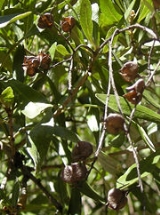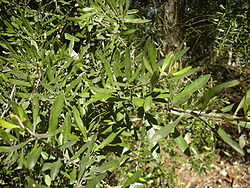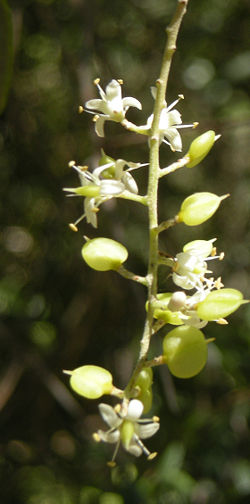
Bursaria spinosa
Encyclopedia
Bursaria spinosa is a small tree
or shrub
in the family Pittosporaceae
. The species occurs in mainly in the eastern and southern half of Australia
and not in Western Australia
and the Northern Territory
. Reaching 10 m (35 ft) high, it bears fragrant white flowers at any time of year but particularly summer. A common understory
shrub of eucalyptus woodland, it aggressively colonises disturbed areas and fallow farmland. It is an important food plant for several species of butterflies and moths, particularly those of the genus Paralucia
.
, Bursaria spinosa was first described by Antonio José Cavanilles
in 1797. It is known by many common names, including Australian blackthorn, Blackthorn, christmas bush, mock orange, native blackthorn, native box, native olive, prickly box, prickly pine, spiny box, spiny bursaria, sweet bursaria, thorn box and whitethorn. Summer flowering has given rise to the name (Tasmanian) christmas bush in Tasmania and South Australia. Indigenous names recorded include kurwan in Coranderrk, Victoria, and geapga from Lake Hindmarsh Station.
Bursaria spinosa is highly variable in appearance and habit, as are other species within the genus, and there have been several attempts at classification since their discovery. The Austrian botanist Aloys Putterlick divided Bursaria spinosa into spiny (spinosa) and lacking spines (inermis) in 1839. Several subspecies have been described, but a 1999 revision of the genus recognises only two, one of which B. spinosa lasiophylla had been considered a separate species.
Thus subspecies spinosa is a 5–10 m shrub or tree found widely across eastern Australia and Tasmania from the Eyre Peninsula, Flinders Ranges and Kangaroo Island in South Australia to north Queensland. Subspecies lasiophylla has shorter, wider leaves and smaller flowers and only reaches 5 m. It replaces the other subspecies on heavier clay soils in southeastern Australia (eastern South Australia and southern New South Wales).
 Bursaria spinosa has a variable habit, and can grow anywhere from 1 to 12 m high. The dark grey bark is furrowed. The smooth branches are sometimes armed with thorns, and the leaves are arranged alternately along the stems or clustered around the nodes. Linear to oval or wedge-shaped (ovate, obovate or cuneate), they are 2–4.3 cm long and 0.3–1.2 cm wide with a rounded apex. The fragrant flowers can occur at any time of year, but mainly appear in the summer. They are arranged in leafy pyramid-shaped panicle
Bursaria spinosa has a variable habit, and can grow anywhere from 1 to 12 m high. The dark grey bark is furrowed. The smooth branches are sometimes armed with thorns, and the leaves are arranged alternately along the stems or clustered around the nodes. Linear to oval or wedge-shaped (ovate, obovate or cuneate), they are 2–4.3 cm long and 0.3–1.2 cm wide with a rounded apex. The fragrant flowers can occur at any time of year, but mainly appear in the summer. They are arranged in leafy pyramid-shaped panicle
s.
plant in association with grey box (Eucalyptus moluccana
) and forest red gum (E. tereticornis
) as well as the grass Themeda australis. It can form thickets on farmland which is ungrazed.
 Living for 25 to 60 years, Bursaria spinosa can resprout from its woody base after bushfire. Highly rhizomatous
Living for 25 to 60 years, Bursaria spinosa can resprout from its woody base after bushfire. Highly rhizomatous
, plants of a stand are often genetically a single plant. Despite being genetically identical, different plants and even single shoots can be very distinct in appearance (for instance, spineless shoots previously regarded as a subspecies "inermis"). Its seed is wind-dispersed and it is a colonising plant.
A wide variety of insects visit the flowers of Bursaria spinosa, the most important pollinators of which appear to be beetles of several families. Common visitors recorded from field work around Armidale were jewel beetle species such as Curis splendens and Stigmodera inflata, longicorn beetles including Amphirhoe sloanei and Tropocalymma dimidiatum, scarab beetles
and tumbling flower beetles
. Beetles and scoliid wasps
all carried significant amounts of pollen. Other visitors such as flies and butterflies carried much lower amounts. The larvae of the jewel beetle species Astraeus crassus live in tunnels in dead and dying branches. Caterpillars which feed on Bursaria spinosa include Proselena annosana, two-ribbed arctiid (Palaeosia bicosta
) and bark looper moth (Ectropis subtinctaria), while those of the clouded footman (Anestia ombrophanes
) graze on algae and lichens which grow on the branches.
The Bright Copper (Paralucia aurifera) and ant species Anonychomyrma nitidiceps form a complex symbiotic relationship on Bursaria spinosa. Butterflies lay their eggs on the underside of the leaves, and the caterpillars feed on the leaves before pupating in the soil at the foot of the plant. The ants excavate chambers in the soil where the caterpillars sleep and later pupate, and accompany the caterpillars when the latter are feeding. They are thought to feed on the caterpillars' secretions. Caterpillars of the Fiery Copper (Paralucia pyrodiscus
) are likewise accompanied by ants of the genus Notoncus, and the third species, the endangered Bathurst Copper (Paralucia spinifera), also breeds and feeds exclusively on the subspecies lasiophylla in Central New South Wales.
Cattle and rabbits graze on young plants..
is harvested from the plant in the Sydney region. Although its thorns make it unpopular in cultivation, Bursaria spinosa provides nectar for butterflies and a safe haven for small birds.
Tree
A tree is a perennial woody plant. It is most often defined as a woody plant that has many secondary branches supported clear of the ground on a single main stem or trunk with clear apical dominance. A minimum height specification at maturity is cited by some authors, varying from 3 m to...
or shrub
Shrub
A shrub or bush is distinguished from a tree by its multiple stems and shorter height, usually under 5–6 m tall. A large number of plants may become either shrubs or trees, depending on the growing conditions they experience...
in the family Pittosporaceae
Pittosporaceae
Pittosporaceae is a family of flowering plants. The family includes approximately 200 species of trees, shrubs, and lianas in 9-10 genera. The species of Pittosporaceae range from tropical to temperate climates of the Afrotropic, Indomalaya, Oceania, and Australasia ecozones.-Genera:* Auranticarpa...
. The species occurs in mainly in the eastern and southern half of Australia
Australia
Australia , officially the Commonwealth of Australia, is a country in the Southern Hemisphere comprising the mainland of the Australian continent, the island of Tasmania, and numerous smaller islands in the Indian and Pacific Oceans. It is the world's sixth-largest country by total area...
and not in Western Australia
Western Australia
Western Australia is a state of Australia, occupying the entire western third of the Australian continent. It is bounded by the Indian Ocean to the north and west, the Great Australian Bight and Indian Ocean to the south, the Northern Territory to the north-east and South Australia to the south-east...
and the Northern Territory
Northern Territory
The Northern Territory is a federal territory of Australia, occupying much of the centre of the mainland continent, as well as the central northern regions...
. Reaching 10 m (35 ft) high, it bears fragrant white flowers at any time of year but particularly summer. A common understory
Understory
Understory is the term for the area of a forest which grows at the lowest height level below the forest canopy. Plants in the understory consist of a mixture of seedlings and saplings of canopy trees together with understory shrubs and herbs...
shrub of eucalyptus woodland, it aggressively colonises disturbed areas and fallow farmland. It is an important food plant for several species of butterflies and moths, particularly those of the genus Paralucia
Paralucia
Paralucia is a genus of butterflies belonging to the family Lycaenidae. The caterpillars feed on Bursaria and sometimes Pittosporum species and co-habit with ants of the genera Anonychomyrma and Notoncus.-Species:...
.
Taxonomy
First collected in the vicinity of Port JacksonPort Jackson
Port Jackson, containing Sydney Harbour, is the natural harbour of Sydney, Australia. It is known for its beauty, and in particular, as the location of the Sydney Opera House and Sydney Harbour Bridge...
, Bursaria spinosa was first described by Antonio José Cavanilles
Antonio José Cavanilles
Antonio José Cavanilles was a leading Spanish taxonomic botanist of the 18th century. He named many plants, particularly from Oceania, his name is abbreviated as Cav...
in 1797. It is known by many common names, including Australian blackthorn, Blackthorn, christmas bush, mock orange, native blackthorn, native box, native olive, prickly box, prickly pine, spiny box, spiny bursaria, sweet bursaria, thorn box and whitethorn. Summer flowering has given rise to the name (Tasmanian) christmas bush in Tasmania and South Australia. Indigenous names recorded include kurwan in Coranderrk, Victoria, and geapga from Lake Hindmarsh Station.
Bursaria spinosa is highly variable in appearance and habit, as are other species within the genus, and there have been several attempts at classification since their discovery. The Austrian botanist Aloys Putterlick divided Bursaria spinosa into spiny (spinosa) and lacking spines (inermis) in 1839. Several subspecies have been described, but a 1999 revision of the genus recognises only two, one of which B. spinosa lasiophylla had been considered a separate species.
Thus subspecies spinosa is a 5–10 m shrub or tree found widely across eastern Australia and Tasmania from the Eyre Peninsula, Flinders Ranges and Kangaroo Island in South Australia to north Queensland. Subspecies lasiophylla has shorter, wider leaves and smaller flowers and only reaches 5 m. It replaces the other subspecies on heavier clay soils in southeastern Australia (eastern South Australia and southern New South Wales).
Description

Panicle
A panicle is a compound raceme, a loose, much-branched indeterminate inflorescence with pedicellate flowers attached along the secondary branches; in other words, a branched cluster of flowers in which the branches are racemes....
s.
Distribution and habitat
In the Sydney region, it grows on clay- and shale-based soils, as an understoryUnderstory
Understory is the term for the area of a forest which grows at the lowest height level below the forest canopy. Plants in the understory consist of a mixture of seedlings and saplings of canopy trees together with understory shrubs and herbs...
plant in association with grey box (Eucalyptus moluccana
Eucalyptus moluccana
Eucalyptus moluccana, commonly known as the grey box or gum-topped box, is a medium sized to occasionally tall tree with rough, persistent bark on the lower trunk, shedding above to leave a smooth whitish or light grey, sometimes shiny surface; hence the original name Eucalyptus hemiphloia, from...
) and forest red gum (E. tereticornis
Eucalyptus tereticornis
Eucalyptus tereticornis is a species of tree native to eastern Australia.It has a great many common names, of which Forest Red Gum is perhaps the most widely known...
) as well as the grass Themeda australis. It can form thickets on farmland which is ungrazed.
Ecology

Rhizome
In botany and dendrology, a rhizome is a characteristically horizontal stem of a plant that is usually found underground, often sending out roots and shoots from its nodes...
, plants of a stand are often genetically a single plant. Despite being genetically identical, different plants and even single shoots can be very distinct in appearance (for instance, spineless shoots previously regarded as a subspecies "inermis"). Its seed is wind-dispersed and it is a colonising plant.
A wide variety of insects visit the flowers of Bursaria spinosa, the most important pollinators of which appear to be beetles of several families. Common visitors recorded from field work around Armidale were jewel beetle species such as Curis splendens and Stigmodera inflata, longicorn beetles including Amphirhoe sloanei and Tropocalymma dimidiatum, scarab beetles
Scarabaeidae
The family Scarabaeidae as currently defined consists of over 30,000 species of beetles worldwide. The species in this large family are often called scarabs or scarab beetles. The classification of this family is fairly unstable, with numerous competing theories, and new proposals appearing quite...
and tumbling flower beetles
Mordellidae
Mordellidae is a family of beetles commonly known as tumbling flower beetles for the typical irregular movements they make when escaping predators, or as pintail beetles due to their abdominal tip which aids them in performing these tumbling movements...
. Beetles and scoliid wasps
Scoliidae
Scoliidae, the scoliid wasps, is a small family represented by 6 genera and about 20 species in North America, but they occur worldwide, with a total of around 300 species. They tend to be black, often marked with yellow or orange, and their wing tips are distinctively corrugated...
all carried significant amounts of pollen. Other visitors such as flies and butterflies carried much lower amounts. The larvae of the jewel beetle species Astraeus crassus live in tunnels in dead and dying branches. Caterpillars which feed on Bursaria spinosa include Proselena annosana, two-ribbed arctiid (Palaeosia bicosta
Palaeosia bicosta
The two-ribbed arctiid is a moth of the Arctiidae family. It is found in south-eastern Australia.The wingspan is about 30 mm.The larvae feed on lichen....
) and bark looper moth (Ectropis subtinctaria), while those of the clouded footman (Anestia ombrophanes
Anestia ombrophanes
The Clouded Footman is a moth of the Arctiidae family. It is known from the Australian Capital Territory, New South Wales, Queensland, Western Australia and Victoria....
) graze on algae and lichens which grow on the branches.
The Bright Copper (Paralucia aurifera) and ant species Anonychomyrma nitidiceps form a complex symbiotic relationship on Bursaria spinosa. Butterflies lay their eggs on the underside of the leaves, and the caterpillars feed on the leaves before pupating in the soil at the foot of the plant. The ants excavate chambers in the soil where the caterpillars sleep and later pupate, and accompany the caterpillars when the latter are feeding. They are thought to feed on the caterpillars' secretions. Caterpillars of the Fiery Copper (Paralucia pyrodiscus
Paralucia pyrodiscus
Paralucia pyrodiscus, commonly known as the Fiery- or Dull Copper, is a butterfly belonging to the family Lycaenidae.-Distribution and habitat:...
) are likewise accompanied by ants of the genus Notoncus, and the third species, the endangered Bathurst Copper (Paralucia spinifera), also breeds and feeds exclusively on the subspecies lasiophylla in Central New South Wales.
Cattle and rabbits graze on young plants..
Uses
The drug aesculinAesculin
Aesculin, also rendered Æsculin or Esculin, is a glucoside that naturally occurs in the horse chestnut , California Buckeye and in daphnin ....
is harvested from the plant in the Sydney region. Although its thorns make it unpopular in cultivation, Bursaria spinosa provides nectar for butterflies and a safe haven for small birds.

